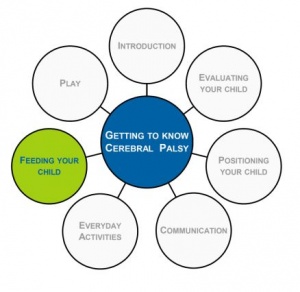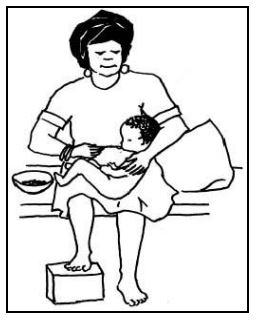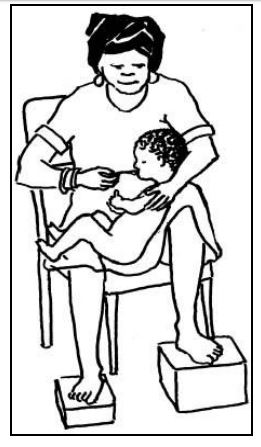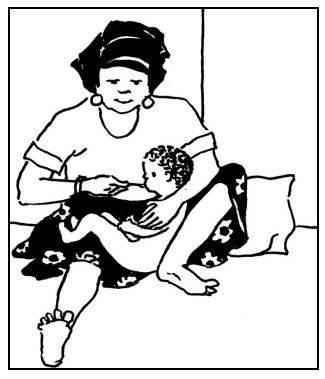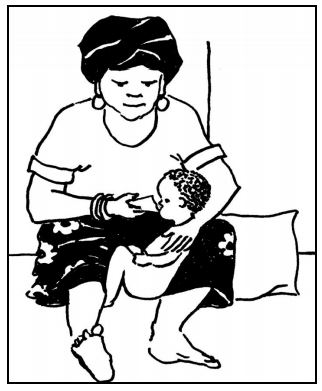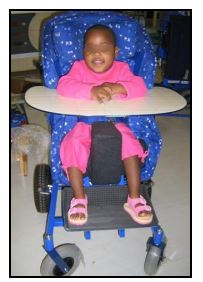Module 6: Feeding Your Child
Page Outcomes [edit | edit source]
When you have finished this workshop:
- You should understand some of the difficulties that a child with cerebral palsy may experience during feeding, and be able to explain these to a family/community member.
- If your child is not independent in eating then you should be able to work out how to make feeding her easier and more enjoyable for both of you.
- If your child has some independence in eating then you should be able to teach her to eat more independently.
- You should know when to ask for help with feeding your child, if needed.
- You should understand the link between chewing and speech development.
Feeding your child[edit | edit source]
Feeding is one of the first abilities that a child usually develops to meet her needs. But many children with cerebral palsy have feeding difficulties, which can sometimes be severe.
List of feeding difficulties:
- Difficulty controlling her head:
o Her head is floppy and she struggles to keep it upright
o Her head is stiff and pushes backwards
- Difficulty controlling her body
o She cannot sit by herself and struggles to keep her body upright
o It is difficult to hold her body upright when feeding her as she pushes back or
struggles to keep her body still
- Difficulty controlling her mouth/lips/tongue
o She struggles to close her mouth
o She struggles to chew her food
o She struggles to swallow / takes a long time before swallowing her food
o She chokes / coughs a lot when eating
o She pushes the food out of her mouth again with her tongue
o She struggles to eat what other children her age are eating and only eats soft food
- Difficulty eating on her own
o She struggles to hold things and bring them to her mouth
Positions for feeding[edit | edit source]
Remember:
- Be sure your child is in a good position before you begin feeding her!
- The position you use will make feeding either easier and safer, or more difficult and unsafe.
- It is especially important that the head and neck are in a good position for feeding to make swallowing easier and safer.
- You can play with your child in these positions too – that way she gets used to the position before you try feeding her, and you also get comfortable with using these positions.
Checklist for good positions for feeding your child:
- Head and body: Straight and upright; back of the neck must be long
- Shoulders and arms: Forward
- Legs: Hips bent
sitting on a chair, couch, or bed to feed[edit | edit source]
Make sure that you are comfortable, with a cushion behind your back and another under your supporting elbow.
Keep your upper arm firmly against the top of her head, and not behind her neck. Make sure you can see your elbow.
- Hold your child’s bottom firmly between your legs so that she cannot push back.
- Raise your leg that is supporting her knees by putting a box under your foot, and use your other leg to make her back straight.
- Bring her arms forward so that her shoulders also come forward.
If your child’s back is very rounded, it may help if you raise your leg that is behind her back even higher than the other leg.
sitting on the floor to feed[edit | edit source]
- Try to sit in a corner so that you can rest your back and your supporting arm.
- Keep your upper arm firmly against the top of your child’s head – not behind her neck. Make sure you can see your elbow.
- Her shoulders and arms are forward.
- Put a cushion under your raised knee to keep yourself comfortable and to keep her back straight.
- Make sure your child’s bottom is well between your legs so that you can keep her hips firmly bent.
For the bigger child, or for one who pushes back very strongly, try resting her bottom firmly on the floor and then push her legs up towards her chest. Place your leg firmly across her feet to hold them flat on the floor.
Extra hints for positioning in this way:
- If your child is sinking down too far between your legs, try putting a firm folded towel under her bottom
- Make sure her shoulders are really well back and supported. Remember her back must be straight, not rounded
- If her back is still too rounded, slip a folded towel over a piece of board behind her back to give her something to lean against
A buggy like this can give your child all the body support thatshe needs, leaving you free to concentrate on your feeding technique.But make sure she is correctly seated and positioned, as you have been shown. It’s no good having equipment and then not using it properly. Positions for feeding the child on her mothers lap are likely to be very difficult with older/bigger children, and are more suitable for younger children.
For those older / bigger children, use of a proper positioning buggy will probably be the only way to achieve a good feeding position.
